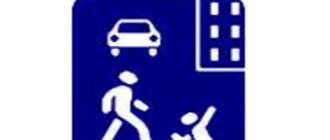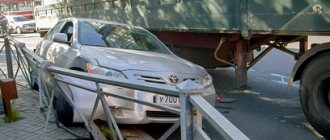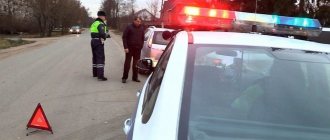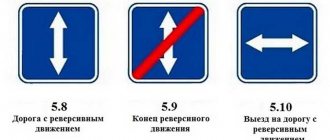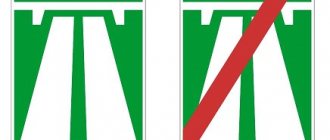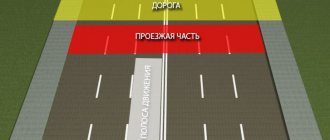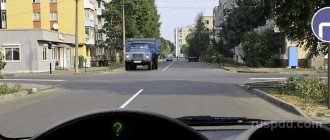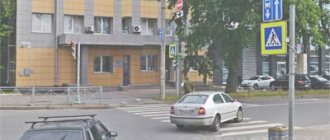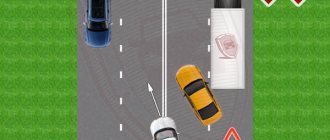The number of vehicles owned by Russians increases by several thousand every year. Therefore, it is not surprising that we spend a decent amount of time in traffic jams every day. Most often, congestion on the roadway occurs in the same place and at certain hours. In this regard, reversible lanes are organized on roads in such areas.
The word reverse itself means return. In road traffic - the ability to move a vehicle in one lane in two directions.
That is, first the flow moves in one direction, and then in the opposite direction. The lane on which the movement takes place remains the same.
Reversible traffic light, what is it?
Every driver has heard about the term “reverse movement”. However, not everyone has encountered it in reality. Reversing movement is often used at a certain period of time when it is required.
The need for these lanes arises on those sections of roads where traffic intensity changes throughout the day. So, for example, in the morning everyone rushes from home to work, and in the evening, vice versa. And in order to avoid hours-long traffic jams, special lanes are being introduced.
Traffic regulation is carried out by means of a traffic light, a traffic police officer or road workers. A reversible traffic light controls traffic in the lane above which it is located.
Sometimes these traffic lights are used in tunnels. Installed above the rows, they make it possible to regulate traffic on the lanes in a short period of time during road accidents or during repair work on the roadway.
The concept of reverse movement
Reversing traffic is movement along certain lanes, changing from one direction to the opposite depending on different times of the day.
This measure is forced and serves to normalize the situation on roads in terms of congestion when there are too many vehicles. Such traffic regulation increases the speed of vehicles by a total of 10 km/h, while the number of vehicles in both directions does not increase, the trip becomes comfortable, without negativity and nerves.
Signs of a reversible lane
Any driver does not want to become the culprit of a traffic accident. Therefore, every car owner is obliged to remember the traffic rules and repeat them from time to time, since changes are made to the rules every year.
So, the main signs of reverse movement that the driver must pay attention to:
- Working reversible traffic light.
- Sign indicating the beginning of a reversible lane.
- Marking in the form of a double broken line on both sides of the strip.
Signs
Reversing movement is indicated by a white arrow with two tips up and down on a blue background. Accordingly, the same sign, but crossed out with a red line, indicates the end of the reverse lane.
When approaching this lane, a sign indicating the number of meters to it informs you. For example, the reverse row is located five hundred meters away. Consequently, a sign with a white double-sided arrow and below a plate with the number 500 m on a white background are installed half a kilometer from the beginning of the strip.
It is worth noting that the coverage area of the “reverse traffic” sign may include intersections. The end of the road with this type of movement is indicated only by the sign “End of reverse movement”.
Marking
Every driver should be able to distinguish between reverse and normal lane traffic. If only because the latter allows you to move only in one direction. And the reverse movement changes over time. Its stripes are located in the center of the roadway. The marking looks like a double broken line. Moreover, the length of the solid (white) part is equal to three lengths of the spaces between them.
Options for applying road markings:
- One line in the center of the road. This marking indicates that the roadway has two lanes with reverse traffic. They are located on both sides of the line, that is, on the right and left sides of it.
- Several lines. With this method of marking, the reversible traffic lane is the one that is limited on both sides by double broken lines.
It is unclear why there are no road signs that would indicate reversible lanes. After all, they are located next to ordinary ones. There is a sign indicating a road that has a reversible lane. But which one exactly is not indicated. Reversing traffic lights are also not helpful in finding a lane. After all, it only regulates movement along it, but does not designate it in any way. To determine where this strip is, there are markings. And this is where the rub comes in. In dry summer weather there will be no problems with determining the location of the strip. But what to do if there is snow or mud that has blocked the lines? After all, if there are no markings, then there are no reversible lanes. No one has yet given an exact answer to this question.
How many reversible lanes are there on the road?
In the foreground for the motorist there should always be signs for the beginning and end of the reverse section, and then a traffic light and markings.
Road markings
Double white dashed lines are used to mark reverse movement. The ratio between the main part of the line and the breaks is 3:1. This markup designation option is called 1.9.
There are no special signs indicating the presence of reverse roads, which requires special attention on the road, especially in winter and in bad weather.
If there are reverse lanes, but there is no reverse traffic light, entering this section is strictly prohibited, since it is located in the center of the highway.
There are two types of markup:
- One line of double broken stripes down the center of the road. Then two stripes, which are located on both sides of the markings, are considered reversible.
- Several reverse lines on the road. Then, reverse lanes are considered to be those road lanes that are marked with markings on both sides.
Road signs
There are several signs of reverse movement:
- Sign 5.8 is depicted as a vertical white stripe with tips up and down - indicating the beginning of the reverse road.
- Sign 5.9 is similar to sign 5.8, but crossed out with a red stripe - indicates the end of the reverse road.
- Sign 5.10 is drawn as a horizontal white stripe with tips pointing left and right. It indicates the presence of a reverse road ahead. The difference between this sign and 5.8 is that it is installed only at intersections.
When turning onto the reverse road, you should adhere to clause 9.8 of the traffic rules. According to it, the driver undertakes to be in the outer lane on the right.
Due to the fact that the reverse type of movement can only be activated on certain days or times, special signs with marks from 8.5.1 to 8.5.7 can be hung along with road signs. Sometimes additional signs are placed indicating the direction of movement along the lanes (5.15.1 or 5.15.7).
Sign 5.15.1 indicates from which lane you are allowed to turn right or left. Thus, turning right at intersections is possible from the extreme right lane, and turning left is possible from the left lane.
Violation of reverse traffic rules is subject to fines, the amount of which depends on the type of violation.
According to Art. 12.15 Code of Administrative Offenses, when leaving the reverse section of the road, you should move to the right lane. For non-compliance, a fine of 500 rubles is issued.
Driving onto a reverse road when the traffic light is not working is prohibited, the fine is 5,000 rubles. Repeated registration of such a violation threatens to confiscate your rights for a whole year. This type of offense is very dangerous and is compared to driving into the oncoming lane.
Ignoring the rules for entering the reverse road in accordance with the traffic light instructions will result in a fine of 1,000 rubles in accordance with Art. 12.12 part 1 of the Administrative Code.
Avoiding obstacles on the road on the left side, entering the oncoming lane (crossing markings 1.9), is considered in accordance with Art. 12.15 Part 3 of the Administrative Code, and the fine is 1000 - 1500 rubles.
Incorrect placement of a car at an intersection, according to Art. 12.15 Part 1 of the Code of Administrative Offenses costs 1,500 rubles as a fine. When turning left from a reversible lane onto a road with normal two-way traffic, you need to ensure that the car takes the extreme right position on it.
Knowing and following the rules on the road means the absence of accidents, fines and traffic jams.
The meaning of reverse traffic light signals
As already mentioned, traffic on the lane is regulated by a reversible traffic light. The rules of travel, according to its signals, are similar to the usual ones. The main difference is the appearance. If in a regular traffic light the signal looks like a circle of red, yellow or green, then in a reverse traffic light it is signs.
Symbols:
- A traffic light signal in the form of a red letter X prohibits movement in the reversible lane above which it is installed, since at this time oncoming traffic begins to travel along it.
- A sign depicting an inclined arrow. Its tip is directed to the right or left side. It reports an imminent change from a prohibiting signal to an enabling signal or vice versa. Moreover, the driver is obliged to change lanes to the one the arrow points to. The yellow signal of a regular round traffic light prohibits movement, but the reverse one does not. You have every right to start driving and not change lanes until the light turns red.
- A traffic light signal in the form of a green arrow allows you to move a vehicle along the lane above which it is installed.
Do not forget that a traffic light regulates traffic only on the reversible lane above which it is located.
Consequences of breaking the rules
Traffic lights and light indicators
Every driver knows that when driving a vehicle on the road, it is necessary to comply with the traffic rules established by the legislation of the Russian Federation, which are designed to establish order and discipline on the highway in order to prevent road accidents and make driving as safe and convenient as possible.
So, the basic rules for driving in the reversible lane include following the traffic lights. However, drivers often violate traffic rules without even knowing it. In some cases, the driver’s inattention leads to negative consequences not only for him, but also for other motorists.
For example, during a yellow traffic light, you have the opportunity to change lanes, but only in the direction in which the arrow points. Otherwise, you may receive a fine for creating an emergency on the road. Pay close attention to the traffic lights and maneuver within the limits of the rules established for reversing traffic.
Another most common violation is changing the traffic lane from reverse to normal. Fines are one of the unpleasant consequences that can overtake a motorist for mistakes made while driving. It should be borne in mind that when crossing roads with reversible traffic, the same rules apply as when driving through regular intersections. However, when changing from a reversible lane to a regular one, the car must be located in the far right lane, where the reversible lane ends (on the right). This arrangement is required no matter which direction you plan to turn.
Remember that crossing the reversible lane markings is only possible if it is on the right side of your vehicle. This rule is especially relevant for situations when it is necessary to change a car from a lane with normal traffic to the reverse lane.
The size of the administrative fine for violating traffic rules when operating a reverse traffic light is not very severe, but is noticeable for any motorist: it can range from 500 rubles to 5,000 rubles. However, this is not the main thing. The main point when violating traffic rules is the risk of adverse consequences in the form of harm to human health, as well as deprivation of his life. By violating the traffic rules established within the operation of a reverse traffic light, you endanger not only your health and life, but also the highest values and benefits of other road users. The reversible traffic light was created with the aim of improving the quality of traffic on the roads, instilling tolerance and respect among motorists, but today in Russia these goals have not yet been achieved.
Driving on the reverse lane
Driving on a road with reversible traffic must be carried out with special care. It requires unquestioning compliance with the rules. The slightest mistake or slowdown, and now there is an oncoming lane in front of you, although only a couple of seconds ago everyone was moving in the same direction as you.
It is allowed to change lanes within the visibility range of a control device on a reversible road when the permit signal is given. If you are moving and a prohibitory signal appears, your actions should be concentrated on leaving the lane as quickly as possible. You also have the opportunity to leave it at any time when given the permission signal.
You can move along the reversible lane until there is a sign indicating its completion. After driving, it is regulated by the usual traffic rules.
The rules for driving on reversible roads can be summarized in several points:
- Entry is permitted when the green or yellow traffic light above the reverse lane is on.
- When the traffic light is off or when the light is red, it is prohibited to move your vehicle into the reverse lane.
- Traffic regulations require an immediate exit from the reverse lane if the traffic light above it turns red or stops working.
How many reversible lanes are there on the road?
This sign is found before intersections where the road being crossed has reverse traffic.
The difference from a regular intersection is that not only when turning right, but also when turning left, you must take the far right lane.
Even if you drive through such an intersection every day and know for sure that there are no reversible lanes, turn into the far right lane.
In the next article we will talk about reversible traffic lights. Good luck on the roads!
Road markings
The lines are different from the usual ones - they are double broken, the distance between them is three times shorter than the painted part. You can enter a lane with markings, but only if there are other markings or a reverse traffic light. You can move out at any time, going to the right edge, and you definitely need to if you see a red traffic light.
Traffic signals
According to the conditions of a reversible traffic light, there are two-color signals: red, green and three-color: red, green, yellow. They do not regulate the flow of all cars, but only the section of the road on which they are installed.
- green color means that entry and use of the reversible road is permitted.
- red – the use of the reverse lane is not allowed; there is a possibility of a collision with oncoming traffic moving in the oncoming lane.
- yellow - get ready, movement in the opposite direction will soon begin, leave the lane immediately. The use of such traffic lights in tunnels and during road repairs has already become a mandatory condition.
The warning signs have the following designations: green is represented as a passing arrow; red – in the shape of a red cross; yellow – an arrow indicating which lane you urgently need to move to.
Special characters
5.8 Indicates the beginning of a “through passage”.
5.9 It is the opposite of the previous one, it is placed at the end of the path and indicates changing lanes to other lanes in the same direction.
5.10 Installed before an intersection crossed by a reversible lane.
Three types of organizing reverse traffic are currently not enough in Russia, so in the future it is planned to adopt experience from Europe and massively introduce parapet-type blocks (concrete structures) to prevent vehicle collisions on reverse lanes.
In practice, there are 2 options for applying reverse markings:
- The only marking line is 1.9 in the center of the road. In this case, 2 stripes are reversible. One located to the right of the marking and one located to the left.
- Several 1.9 marking lines on the road. In this case, reversible stripes are those that are limited on both sides by reverse markings.
It is curious that there are no signs to indicate reversible lanes. There is only a sign indicating a road with a reversible lane. But what lanes the traffic is on can only be judged by the markings. As for reversible traffic lights, they only regulate the order of movement and do not indicate lanes.
At the same time, under unfavorable road conditions (snow, mud, or markings worn out over time), problems may arise with determining boundaries or the presence of reversible lanes. After all, the absence of markings means the absence of stripes.
Reversing traffic is a necessary measure to relieve congestion on road lanes during periods of heavy traffic congestion or road repairs. Traffic police officers are responsible for regulating this area.
Its positive quality lies in increasing the level of throughput on a specific section of the road, which allows you to spend less time covering this section.
Advantages:
- Unloading of main city highways.
- No need to build additional roads.
- Ensuring uninterrupted traffic flow.
- Uniform distribution of road load.
Organization requires a lot of analytical and organizational work, as well as taking into account a lot of nuances. According to the current rules, for the correct operation of the system the following is required:
- Road signs.
- Marking.
- Special traffic lights.
Nuances of reverse movement
An interesting fact about a yellow reverse traffic light: the tip of the arrow can point to any adjacent side. Changing over to the right lane is, in principle, quite simple. But going to the left is an interesting maneuver. After all, the direction of the arrow does not oblige you to change lanes strictly to the indicated side, but only informs. Based on this, when asked to turn left, you can move into the right lane, which is also permitted, without violating traffic rules.
Drivers are often punished for making the wrong exit from a reverse road onto a regular one. In order not to shell out your hard-earned money for a fine, you need to remember one of the points of the traffic rules. Your vehicle should be positioned in the far right lane, at an intersection where the reversible lane ends on the right. Even if you plan to turn left later.
The intersection of roads with reverse traffic is carried out taking into account the same rules as the passage of regular intersections. You should always remember this, and moving around will not be difficult.
Stopping on a road with reverse traffic is strictly prohibited.
It is allowed to cross the markings only if its location is on the right side relative to you.
Fine for violating traffic rules when driving in reverse
Following the rules is an integral part of staying safe on the road. Accordingly, such a measure to reduce the speed of covering a section of road is no exception. Failure to comply with the strictly prescribed procedure when moving along a section of the road where movement in both directions is possible is punishable by imposing a penalty on the offender.
The amount of the financial fine is determined by the type of violation:
- If a person driving a car does not change to the right lane while leaving such a part of the road, then he must pay a fine of five hundred rubles.
- If a special traffic light does not work for some reason, and the driver enters the reversible lane, then the fine increases to five thousand.
- It is worth noting that a fine is imposed in the case of the first violation; a repetition of a similar situation may well entail confiscation of the driver’s license for one year.
Fines
Any failure to comply with traffic rules entails punishment. What kind of punishment you face for not complying, of course, depends on what you violated.
For example, if you turn incorrectly into the reverse lane, you will receive a fine of five hundred rubles or more. And for leaving when the traffic light is turned off or there is no traffic light, the penalty is twice as heavy. It makes no sense to list all preventive measures, since changes are often made to traffic rules. The main thing is to remember that your failure to follow traffic rules may subsequently deprive another person of their life.
